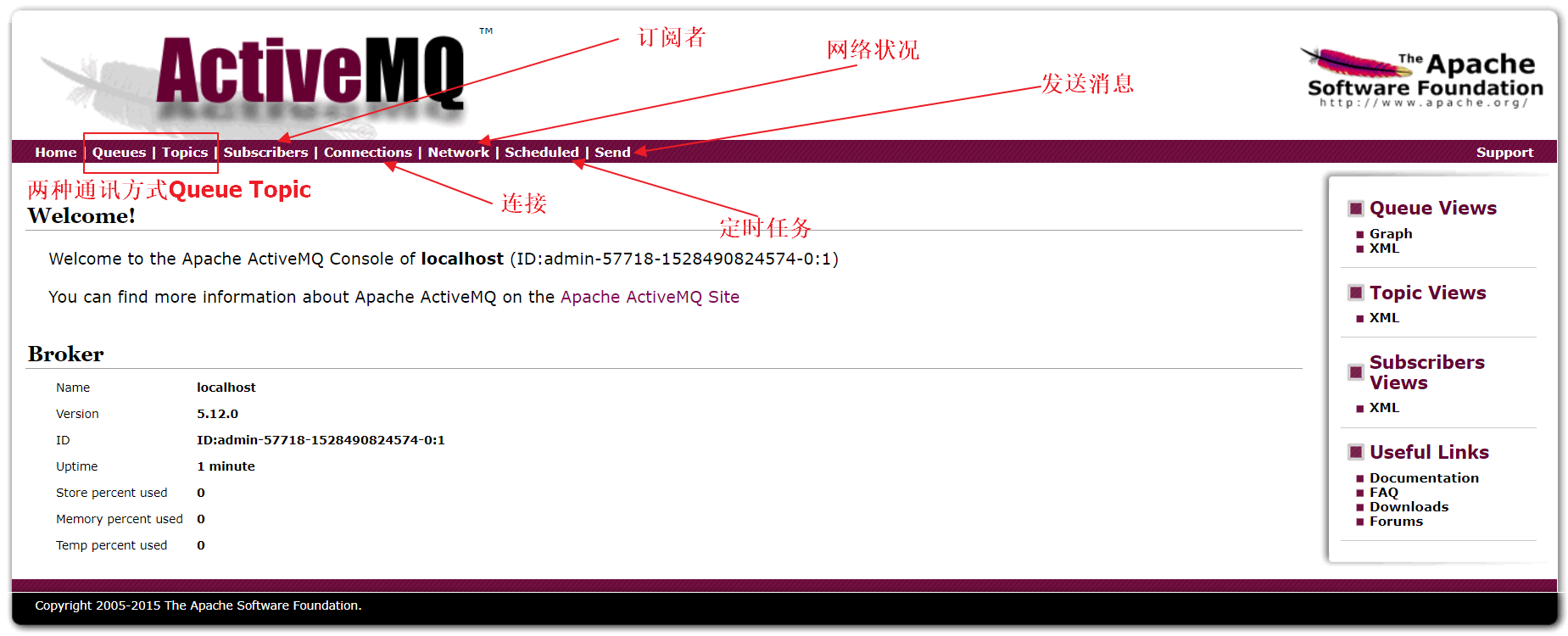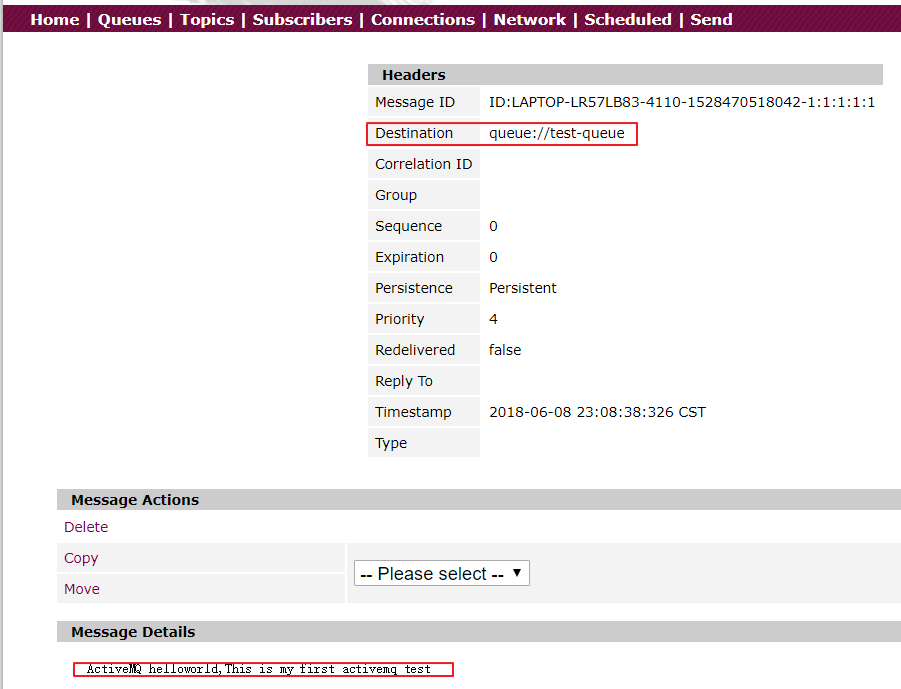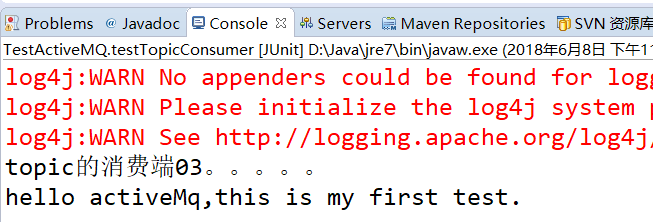ActiveMQ安装及使用
1 安装环境
1、需要jdk
2、安装Linux系统。生产环境都是Linux系统。
2 安装步骤
第一步: 把ActiveMQ 的压缩包上传到Linux系统。
第二步:解压缩。
第三步:关闭防火墙
临时关闭:service iptables stop
写入配置文件,开机也不启动 chkconfig iptables off
第四步:启动activemq服务
使用bin目录下的activemq命令启动:
# ./activemq start 启动服务
# ./activemq stop 停止服务
# ./activemq status 查看服务的状态
注意:如果ActiveMQ整合spring时,一定不要使用activemq-all-5.12.0.jar包。建议使用5.11.2
3 管理后台
1 进入管理后台
http://192.168.25.168:8161


登录进来之后的界面如下:

4 linux activemq 出现无法访问的解决

出现上面错误的原因是因为机器名和ip地址没有对应上。
解决方式:
1.用cat /etc/sysconfig/network 命名查看主机名
# cat /etc/sysconfig/network

2.查看hosts文件
# cat /etc/hosts 查看hosts文件

如果你的机器名(我的是admin)没有在hosts文件里面,就需要将你的机器名加入到hosts的文件里面。
也可以修改你的机器名为hosts文件里面已有的项
3. 修改完成之后重启activemq服务就可以访问了。
5 Queue
1 Producer
生产者:生产消息,发送端。
把jar包添加到工程中。使用5.11.2版本的jar包。

第一步:创建ConnectionFactory对象,需要指定服务端ip及端口号。
第二步:使用ConnectionFactory对象创建一个Connection对象。
第三步:开启连接,调用Connection对象的start方法。
第四步:使用Connection对象创建一个Session对象。
第五步:使用Session对象创建一个Destination对象(topic、queue),此处创建一个Queue对象。
第六步:使用Session对象创建一个Producer对象。
第七步:创建一个Message对象,创建一个TextMessage对象。
第八步:使用Producer对象发送消息。
第九步:关闭资源。
package cn.e3mall.activeMQ; import javax.jms.Connection;
import javax.jms.ConnectionFactory;
import javax.jms.MessageProducer;
import javax.jms.Queue;
import javax.jms.Session;
import javax.jms.TextMessage; import org.apache.activemq.ActiveMQConnectionFactory;
import org.junit.Test; /**
* 测试activeMQ
*
* @title:TestActiveMQ
* @description:
* @author jepson
* @date 2018年6月8日 下午10:50:14
* @version 1.0
*/
public class TestActiveMQ { @Test
public void testQueueProducer() throws Exception {
// 第一步:创建ConnectionFactory对象,需要指定服务端ip及端口号。
// brokerURL服务器的ip及端口号,端口号是61616,web服务的端口号是8161
String brokerURL="tcp://192.168.25.131:61616";
ConnectionFactory connectionFactory = new ActiveMQConnectionFactory(brokerURL); // 第二步:使用ConnectionFactory对象创建一个Connection对象。
Connection connection = connectionFactory.createConnection(); // 第三步:开启连接,调用Connection对象的start方法。
connection.start(); // 第四步:使用Connection对象创建一个Session对象。
/*
*第一个参数:是否开启事务。
*如果true开启事务,第二个参数无意义。一般不开启事务。事务的意思就是没有发出去就重发
*
*第二个参数:当第一个参数为false时,第二个参数才有意义。
*表示消息的应答模式。1、自动应答2、手动应答。一般是自动应答。
*/
Session session = connection.createSession(false, Session.AUTO_ACKNOWLEDGE); // 第五步:使用Session对象创建一个Destination对象(topic、queue),此处创建一个Queue对象。
//参数:队列的名称。
Queue queue = session.createQueue("test-queue"); // 第六步:使用Session对象创建一个Producer对象。
MessageProducer producer = session.createProducer(queue); // 第七步:创建一个Message对象,创建一个TextMessage对象。
TextMessage message = session.createTextMessage("ActiveMQ helloworld,This is my first activemq test"); // 第八步:使用Producer对象发送消息。
producer.send(message); // 第九步:关闭资源。
producer.close();
session.close();
connection.close();
}
}
运行测试程序,然后查看web服务端

点击test-queue


2 Consumer
消费者:接收消息。
第一步:创建一个ConnectionFactory对象。
第二步:从ConnectionFactory对象中获得一个Connection对象。
第三步:开启连接。调用Connection对象的start方法。
第四步:使用Connection对象创建一个Session对象。
第五步:使用Session对象创建一个Destination对象。和发送端保持一致queue,并且队列的名称一致。
第六步:使用Session对象创建一个Consumer对象。
第七步:接收消息。
第八步:打印消息。
第九步:关闭资源
@Test
public void testQueueConsumer() throws Exception {
// 第一步:创建一个ConnectionFactory对象连接MQ服务器。
String brokerURL = "tcp://192.168.25.131:61616";
ConnectionFactory connectionFactory = new ActiveMQConnectionFactory(brokerURL); // 第二步:从ConnectionFactory对象中获得一个Connection对象。
Connection connection = connectionFactory.createConnection(); // 第三步:开启连接。调用Connection对象的start方法。
connection.start(); // 第四步:使用Connection对象创建一个Session对象。
Session session = connection.createSession(false, Session.AUTO_ACKNOWLEDGE); // 第五步:使用Session对象创建一个Destination对象。和发送端保持一致queue,并且队列的名称一致。
Queue queue = session.createQueue("test-queue"); // 第六步:使用Session对象创建一个Consumer对象。
MessageConsumer consumer = session.createConsumer(queue); // 第七步:接收消息。
consumer.setMessageListener(new MessageListener() {
@Override
public void onMessage(Message message) {
try {
TextMessage textMessage = (TextMessage) message;
String text =null;
//取消息的内容
text = textMessage.getText();
// 第八步:打印消息。
System.out.println(text);
} catch (JMSException e) {
e.printStackTrace();
}
}
});
//等待键盘输入
System.in.read();
// 第九步:关闭资源
consumer.close();
session.close();
connection.close();
}
运行上面的测试程序,然后可以在控制看到消费者拿到了消息内容

我们再去查看一个web服务端

6 Topic
1 Producer
使用步骤:
第一步:创建ConnectionFactory对象,需要指定服务端ip及端口号。
第二步:使用ConnectionFactory对象创建一个Connection对象。
第三步:开启连接,调用Connection对象的start方法。
第四步:使用Connection对象创建一个Session对象。
第五步:使用Session对象创建一个Destination对象(topic、queue),此处创建一个Topic对象。
第六步:使用Session对象创建一个Producer对象。
第七步:创建一个Message对象,创建一个TextMessage对象。
第八步:使用Producer对象发送消息。
第九步:关闭资源。
@Test
public void testTopicProducer() throws Exception {
// 第一步:创建ConnectionFactory对象,需要指定服务端ip及端口号。
// brokerURL服务器的ip及端口号,端口号是61616,web服务的端口号是8161
String brokerURL="tcp://192.168.25.131:61616";
ConnectionFactory connectionFactory = new ActiveMQConnectionFactory(brokerURL); // 第二步:使用ConnectionFactory对象创建一个Connection对象。
Connection connection = connectionFactory.createConnection(); // 第三步:开启连接,调用Connection对象的start方法。
connection.start(); // 第四步:使用Connection对象创建一个Session对象。
/*
*第一个参数:是否开启事务。
*如果true开启事务,第二个参数无意义。一般不开启事务。事务的意思就是没有发出去就重发
*
*第二个参数:当第一个参数为false时,第二个参数才有意义。
*表示消息的应答模式。1、自动应答2、手动应答。一般是自动应答。
*/
Session session = connection.createSession(false, Session.AUTO_ACKNOWLEDGE); // 第五步:使用Session对象创建一个Destination对象(topic、queue),此处创建一个Topic对象。
//参数:队列的名称。
Topic topic = session.createTopic("test-topic"); // 第六步:使用Session对象创建一个Producer对象。
MessageProducer producer = session.createProducer(topic); // 第七步:创建一个Message对象,创建一个TextMessage对象。
/*
* TextMessage message = new ActiveMQTextMessage(); message.setText(
* "hello activeMq,this is my first test.");
*/
TextMessage message = session.createTextMessage("hello activeMq,this is my first test."); // 第八步:使用Producer对象发送消息。
producer.send(message); // 第九步:关闭资源。
producer.close();
session.close();
connection.close();
}
2 Consumer
消费者:接收消息。
第一步:创建一个ConnectionFactory对象。
第二步:从ConnectionFactory对象中获得一个Connection对象。
第三步:开启连接。调用Connection对象的start方法。
第四步:使用Connection对象创建一个Session对象。
第五步:使用Session对象创建一个Destination对象。和发送端保持一致topic,并且话题的名称一致。
第六步:使用Session对象创建一个Consumer对象。
第七步:接收消息。
第八步:打印消息。
第九步:关闭资源
@Test
public void testTopicConsumer() throws Exception {
// 第一步:创建一个ConnectionFactory对象连接MQ服务器。
String brokerURL = "tcp://192.168.25.131:61616";
ConnectionFactory connectionFactory = new ActiveMQConnectionFactory(brokerURL); // 第二步:从ConnectionFactory对象中获得一个Connection对象。
Connection connection = connectionFactory.createConnection(); // 第三步:开启连接。调用Connection对象的start方法。
connection.start(); // 第四步:使用Connection对象创建一个Session对象。
Session session = connection.createSession(false, Session.AUTO_ACKNOWLEDGE); // 第五步:使用Session对象创建一个Destination对象。和发送端保持一致topic,并且话题的名称一致。
Topic topic = session.createTopic("test-topic"); // 第六步:使用Session对象创建一个Consumer对象。
MessageConsumer consumer = session.createConsumer(topic); // 第七步:接收消息。
consumer.setMessageListener(new MessageListener() {
@Override
public void onMessage(Message message) {
try {
TextMessage textMessage = (TextMessage) message;
String text =null;
//取消息的内容
text = textMessage.getText();
// 第八步:打印消息。
System.out.println(text);
} catch (JMSException e) {
e.printStackTrace();
}
}
});
System.out.println("topic的消费端01。。。。。");
//等待键盘输入
System.in.read();
// 第九步:关闭资源
consumer.close();
session.close();
connection.close();
}
3 测试
1 测试一
运行producer生成者

可以看到消息发送了一个,没有发送到任何消费者。消息不会持久化,直接丢失掉了,点击test-topic也看不到发送的消息内容。
2 测试二
运行consumer消费者3次,相当于启动了三个消费者。分别修改输出,用以区分.。
System.out.println("topic的消费端01。。。。。");
System.out.println("topic的消费端02。。。。。");
System.out.println("topic的消费端03。。。。。");
然后运行producer
会发现三个消费者都能够收到消息



然后我们查看一下web服务端

可以看到有3个消费者,发送了2次消息【测试一发送一次,所以总的是两次】,3条消息已出队。
如果我们在运行一次producer,会显示发送了消息3次,6条消息已出队

7 Quene 和 Topic的区别
Quene:点对点,消息会被持久化
Topic:广播,消息不会被持久化
8 activemq和spring的整合
第一步:引入相关的jar包
<!-- ActiveMQ客户端依赖的jar包 -->
<dependency>
<groupId>org.apache.activemq</groupId>
<artifactId>activemq-all</artifactId>
</dependency> <dependency>
<groupId>org.springframework</groupId>
<artifactId>spring-jms</artifactId>
</dependency>
<dependency>
<groupId>org.springframework</groupId>
<artifactId>spring-context-support</artifactId>
</dependency>
第二步:producer生产者的spring配置文件
<?xml version="1.0" encoding="UTF-8"?>
<beans xmlns="http://www.springframework.org/schema/beans"
xmlns:context="http://www.springframework.org/schema/context"
xmlns:p="http://www.springframework.org/schema/p"
xmlns:aop="http://www.springframework.org/schema/aop"
xmlns:tx="http://www.springframework.org/schema/tx"
xmlns:xsi="http://www.w3.org/2001/XMLSchema-instance"
xsi:schemaLocation="http://www.springframework.org/schema/beans
http://www.springframework.org/schema/beans/spring-beans-4.2.xsd
http://www.springframework.org/schema/context
http://www.springframework.org/schema/context/spring-context-4.2.xsd
http://www.springframework.org/schema/aop
http://www.springframework.org/schema/aop/spring-aop-4.2.xsd
http://www.springframework.org/schema/tx
http://www.springframework.org/schema/tx/spring-tx-4.2.xsd
http://www.springframework.org/schema/util
http://www.springframework.org/schema/util/spring-util-4.2.xsd">
<!-- 真正可以产生Connection的ConnectionFactory,由对应的 JMS服务厂商提供 -->
<bean id="targetConnectionFactory" class="org.apache.activemq.ActiveMQConnectionFactory">
<property name="brokerURL" value="tcp://47.93.53.127:61616" />
</bean>
<!-- Spring用于管理真正的ConnectionFactory的ConnectionFactory -->
<bean id="connectionFactory"
class="org.springframework.jms.connection.SingleConnectionFactory">
<!-- 目标ConnectionFactory对应真实的可以产生JMS Connection的ConnectionFactory -->
<property name="targetConnectionFactory" ref="targetConnectionFactory" />
</bean>
<!-- 配置生产者 -->
<!-- Spring提供的JMS工具类,它可以进行消息发送、接收等 -->
<bean id="jmsTemplate" class="org.springframework.jms.core.JmsTemplate">
<!-- 这个connectionFactory对应的是我们定义的Spring提供的那个ConnectionFactory对象 -->
<property name="connectionFactory" ref="connectionFactory" />
</bean>
<!--这个是队列目的地,点对点的 -->
<bean id="queueDestination" class="org.apache.activemq.command.ActiveMQQueue">
<constructor-arg>
<value>spring-queue</value>
</constructor-arg>
</bean>
<!--这个是主题目的地,一对多的 -->
<bean id="topicDestination" class="org.apache.activemq.command.ActiveMQTopic">
<constructor-arg value="topic" />
</bean>
</beans>
第三步:生产者的代码
package cn.e3mall.activeMQ; import javax.jms.Destination;
import javax.jms.JMSException;
import javax.jms.Message;
import javax.jms.Session;
import javax.jms.TextMessage; import org.junit.Test;
import org.springframework.context.ApplicationContext;
import org.springframework.context.support.ClassPathXmlApplicationContext;
import org.springframework.jms.core.JmsTemplate;
import org.springframework.jms.core.MessageCreator; /**
* 测试spring整合activemq
* @title:TestSpringActiveMQ
* @description:
* @author jepson
* @date 2018年6月10日 下午5:41:47
* @version 1.0
*/
public class TestSpringActiveMQ { @Test
public void testSpringActiveMq() throws Exception {
//初始化spring容器
ApplicationContext applicationContext = new ClassPathXmlApplicationContext("classpath:spring/applicationContext-activemq.xml");
//从spring容器中获得JmsTemplate对象
JmsTemplate jmsTemplate = applicationContext.getBean(JmsTemplate.class);
//从spring容器中取Destination对象
Destination destination = (Destination) applicationContext.getBean("queueDestination");
//使用JmsTemplate对象发送消息。
jmsTemplate.send(destination, new MessageCreator() { @Override
public Message createMessage(Session session) throws JMSException {
//创建一个消息对象并返回
TextMessage textMessage = session.createTextMessage("spring activemq queue message");
return textMessage;
}
});
}
}
第四步:MessageListener代码实现
package cn.e3mall.search.listener; import javax.jms.JMSException;
import javax.jms.Message;
import javax.jms.MessageListener;
import javax.jms.TextMessage; /**
* 测试消息接收
* @title:MyMessageListener
* @description:
* @author jepson
* @date 2018年6月10日 下午7:01:04
* @version 1.0
*/
public class MyMessageListener implements MessageListener{ @Override
public void onMessage(Message message) {
try {
TextMessage textMessage = (TextMessage) message;
//取消息内容
String text = textMessage.getText();
System.out.println(text);
} catch (JMSException e) {
e.printStackTrace();
}
}
}
第五步:consumer消费者的spring配置文件
<?xml version="1.0" encoding="UTF-8"?>
<beans xmlns="http://www.springframework.org/schema/beans"
xmlns:context="http://www.springframework.org/schema/context"
xmlns:p="http://www.springframework.org/schema/p"
xmlns:aop="http://www.springframework.org/schema/aop"
xmlns:tx="http://www.springframework.org/schema/tx"
xmlns:xsi="http://www.w3.org/2001/XMLSchema-instance"
xsi:schemaLocation="http://www.springframework.org/schema/beans
http://www.springframework.org/schema/beans/spring-beans-4.2.xsd
http://www.springframework.org/schema/context
http://www.springframework.org/schema/context/spring-context-4.2.xsd
http://www.springframework.org/schema/aop
http://www.springframework.org/schema/aop/spring-aop-4.2.xsd
http://www.springframework.org/schema/tx
http://www.springframework.org/schema/tx/spring-tx-4.2.xsd
http://www.springframework.org/schema/util
http://www.springframework.org/schema/util/spring-util-4.2.xsd">
<!-- 真正可以产生Connection的ConnectionFactory,由对应的 JMS服务厂商提供 -->
<bean id="targetConnectionFactory" class="org.apache.activemq.ActiveMQConnectionFactory">
<property name="brokerURL" value="tcp://47.93.53.127:61616" />
</bean>
<!-- Spring用于管理真正的ConnectionFactory的ConnectionFactory -->
<bean id="connectionFactory"
class="org.springframework.jms.connection.SingleConnectionFactory">
<!-- 目标ConnectionFactory对应真实的可以产生JMS Connection的ConnectionFactory -->
<property name="targetConnectionFactory" ref="targetConnectionFactory" />
</bean>
<!-- 配置生产者 -->
<!-- Spring提供的JMS工具类,它可以进行消息发送、接收等 -->
<bean id="jmsTemplate" class="org.springframework.jms.core.JmsTemplate">
<!-- 这个connectionFactory对应的是我们定义的Spring提供的那个ConnectionFactory对象 -->
<property name="connectionFactory" ref="connectionFactory" />
</bean>
<!--这个是队列目的地,点对点的 -->
<bean id="queueDestination" class="org.apache.activemq.command.ActiveMQQueue">
<constructor-arg>
<value>spring-queue</value>
</constructor-arg>
</bean>
<!--这个是主题目的地,一对多的 -->
<bean id="topicDestination" class="org.apache.activemq.command.ActiveMQTopic">
<constructor-arg value="topic" />
</bean>
<!-- 接收消息 -->
<!-- 配置监听器 -->
<bean id="myMessageListener" class="cn.e3mall.search.listener.MyMessageListener" />
<!-- 消息监听容器 -->
<bean class="org.springframework.jms.listener.DefaultMessageListenerContainer">
<property name="connectionFactory" ref="connectionFactory" />
<property name="destination" ref="queueDestination" />
<property name="messageListener" ref="myMessageListener" />
</bean>
</beans>
第六步:测试消费
package cn.e3mall.activemq; import org.junit.Test;
import org.springframework.context.ApplicationContext;
import org.springframework.context.support.ClassPathXmlApplicationContext; /**
*
* @title:MessageConsumer
* @description:
* @author jepson
* @date 2018年6月10日 下午7:07:29
* @version 1.0
*/
public class MessageConsumer {
@Test
public void testQueueConsumer() throws Exception {
//初始化spring容器
ApplicationContext applicationContext = new ClassPathXmlApplicationContext("classpath:spring/applicationContext-activemq.xml");
//等待
System.in.read();
}
}
ActiveMQ安装及使用的更多相关文章
- Java JMS 程序基础 与 ActiveMQ 安装(一)
一 ActiveMQ安装 从Apache官网上下载 ActivieMQ的安装包 apache-activemq-5.9.1-bin.tar.gz, 并拷贝到linux的安装目录解压 # tar -zx ...
- ActiveMQ安装配置及使用 转发 https://www.cnblogs.com/hushaojun/p/6016709.html
ActiveMQ安装配置及使用 ActiveMQ介绍 ActiveMQ 是Apache出品,最流行的,能力强劲的开源消息总线.ActiveMQ 是一个完全支持JMS1.1和J2EE 1.4规范的 JM ...
- ActiveMQ安装配置及使用
ActiveMQ介绍 ActiveMQ 是Apache出品,最流行的,能力强劲的开源消息总线.ActiveMQ 是一个完全支持JMS1.1和J2EE 1.4规范的 JMS Provider实现,尽管J ...
- ActiveMQ安装与入门程序 & JMS的消息结构
1.Activemq安装 直接到官网下载:记住apache的官网是域名反过来,比如我们找activemq就是activemq.apache.org. 最新版本要求最低的JDK是8,所以最好在电脑装多个 ...
- activeMQ 安装及启动异常处理
一.环境: [root@centos_6 ~]# cat /etc/system-release CentOS release 6.5 (Final) [root@centos_6 ~]# uname ...
- Windows下ActiveMq安装与使用
一.activeMq安装与启动 Apache Active MQ的官网 :http://activemq.apache.org/ 下载地址: http://activemq.apache.org/ac ...
- linux下activemq安装与配置activemq-5.15.2
linux下activemq安装与配置 前提 配置好jdk环境 一.下载:apache-activemq-5.15.2-bin.tar.gz https://archive.apache.org/ ...
- springboot之activemq安装与实践
环境:腾讯云centos7 注意:activemq安装插件,可能会报错.本人是主机名的问题,所以修改了主机名. vim /etc/hosts vim /etc/hostname 修改这两个文件,并重启 ...
- 开源消息服务中间件ActiveMQ安装部署
1.下载ActiveMQ 去官方网站下载:http://activemq.apache.org/ 2.运行ActiveMQ 解压缩apache-activemq-5.5.1-bin.zip 启动Act ...
- ActiveMQ此例简单介绍基于docker的activemq安装与集群搭建
ActiveMQ拓展连接 此例简单介绍基于Docker的activemq安装与集群搭建 一 :安装 1.获取activemq镜像 docker pull webcenter/activemq 2.启动 ...
随机推荐
- 数据集和JSON相互转换
使用DELPHI原生类实现数据集和JSON相互转换 JSON二要素:数组和对象.对象可以包含数组,数组可以包含对象.无层数限制.OLEVARIANT也类似,OLEVARIANT的一个元素又可以是OL ...
- [编译,报错以及其他] 有关C/C++中int不能用-2147483648当最小值的问题
这个取决于今早看耗子叔的微博: 这里说到了int的取值范围的问题,int的取值是-2147483648 ~ 2147483647,但是如果直接在编译器(VS2013)中使用-2147483648会报错 ...
- Linux(一) - Unix&Linux 历史
Unix Unix 的诞生 Unix的历史可以追溯到20世纪60年代中期,当时麻省理工学院,AT&T,贝尔实验室和通用电气公司联合开发了一种名为Multics的操作系统,Multics 中存在 ...
- 教你如何学python
首先,你要有自信心,要明确学习目的.学Python,可以解决在软件使用中所遇到的问题,可以为找到理想工作添加重要砝码.还能锻炼思维,使我们的逻辑思维更加严密:能不断享受到创新的乐趣,将走在高科技的前沿 ...
- 一次HTTP通信过程
当我们在浏览器地址栏输入一个网址然后回车以后就看到了一个对应网址的网页,那这个过程到底是怎样的?都发生了什么? 大致是这几个步骤 服务器的应答部分是包含应答状态码:比较常见的是 200:ok 403: ...
- mysql5.7 创建新表时提示时间戳非法
# 背景 mysql版本5.7.8,需要创建新表,研发提供的sql文件,执行后报错如下: ERROR (): Invalid default value for 'deleted_at' 就猜测到时因 ...
- 指定的 LINQ 表达式包含对与不同上下文关联的查询的引用
解决方法是分两次查询. 报错的原因是在涉及到内存中的对象与EF里的对象混合查询时,内存中的对象要是基元类型. 第一次查询实际上会因为EF的延时加载,不会立即将数据查询到内存中. 解决方法是对第一次查询 ...
- 如何进入PageAdmin CMS 安装界面
一般下面几个应用场景如第一次使用PageAdmin配置参数.服务器迁移.主域名更换.忘记超级管理员密码等都可以在安装界面进行设置. 下面为PageAdmin安装步骤 1.地址栏输入:http://您的 ...
- 如何成功导入SlidingMenu库?
SlidingMenu是一个开源的侧滑菜单(https://github.com/jfeinstein10/SlidingMenu). 为大家的安卓程序提供侧滑菜单,这个功能也非常有用. 要想正常使 ...
- java的string和==和equals和hashcode简单理解
String s1= "abc"; s1是引用变量,在栈里面,如果java的String常量池中没有abc,则开拓一块区域存abc,s1指向常量池中的abc: String s2= ...
